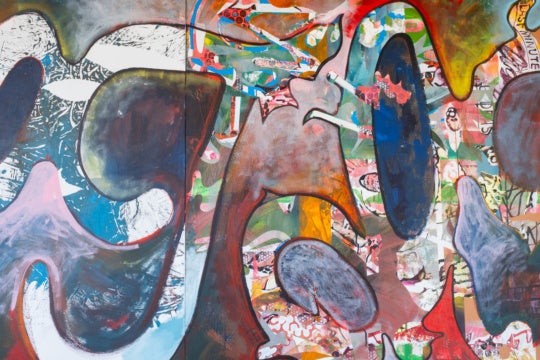
The High Museum of Art makes its first foray into fashion with the exhibition “Transforming Fashion: Iris Van Herpen,” a move that seems, somewhat paradoxically, both belated and daring at once.
Museums have been displaying the work of fashion designers for several decades now, so the High’s late entry into the game is puzzling. Fashion is art’s distant cousin, one that makes no secret about its coziness with commerce, advertising, and popular appeal. Museums were ostensibly designed to remain above such concerns, and the institutions, even as a mere pretense, must still put up a front of keeping fashion’s embarrassing friends at a respectable distance, even though that boisterous crowd wandered in and took over long ago. The High, having exhibited cars, Coke bottles, and jewelry, could never really claim to be too genteel or scholarly for fashion. The delayed foray doesn’t seem admirably skeptical, just sluggish.

What’s so surprising about the exhibition then is that the High selected such an appealingly peculiar and singular designer. Iris van Herpen, at least at the beginning of her career, created her work far outside, both conceptually and literally, the haute couture world of Paris runways. Van Herpen grew up on a farm in a small village outside of Amsterdam. She studied design at the Netherlands’ ArtEZ Institute of the Arts, and then interned with renowned fashion innovator Alexander McQueen, starting her own independent label in Amsterdam in 2007.
From the beginning, it was clear that van Herpen was working in an unusual way, welcoming technology, fabricating strange new materials and integrating innovative mechanical processes into a realm that seemed, almost by definition, resolutely devoted to the handmade, the genuine, and the artisanal. Her work, like McQueen’s, combines an old-fashioned love of beauty with a distinctly contemporary sense of daring and danger. Garments billow and twist like industrial smoke (the literal inspiration for one of her collections) or encase the body as if for mummification. The pieces often suggest the natural world, but seldom the natural world of pretty flowers and falling leaves, more often the one of bones, spikes, brightly toxic insects, mutating cellular structures, scales, ice shards, and stingers.

A visit to the exhibition, which was co-organized with the Groninger Museum in Rotterdam, is every bit as enjoyable as it sounds. Van Herpen’s work can be thought of, and is offered here, as sculpture for the body, and in the best of her work she shares a sculptor’s fascination with and understanding of physical material; a sculptor’s obsession with the way a substance can fascinate, haunt, frighten, and attract is evident in her work (though, crucially, meaning remains at a more dissatisfying remove).

Garments are made to be worn, and they occasionally seem lifeless on mannequins. In the gallery, which features 45 pieces created since 2008, there are accompanying projected videos of models wearing the designs, which help a little. Most insightfully, there is an additional room where visitors are allowed to get to experience van Herpen’s innovative materials through touch. Strangely, her garments come most alive through the photos of Bart Oomes, which are shown throughout the exhibition (the resolution and quality of the reproductions of his photos could be much better here) and in the catalogue. Wall text is a little too high on interpretation and veneration, a little too low on the more interesting and enlightening factual information about process and technique.
Still, the High’s first foray into fashion (and van Herpen’s first solo show at a museum) is a success. Though her garments are designed for women’s bodies and incorporate a number of dark thematic subjects, one seldom gets the uncomfortable feeling, as can happen with other fashion designers, that Van Herpen is creating broad, problematic statements about women and their position in the world; she works, I believe, from the notion of a woman’s body as a physical form occupying space, removed as much as possible from ideas about power, personality, objectification, sex and so on. There’s an unexpected inviting warmth, openness and accessibility to her work, and a respect for the beautiful that engages technology as a new means to a very old end.
“Transforming Fashion: Iris Van Herpen,” co-organized with the Groninger Museum in Gronigen, the Netherlands, is at the High Museum of Art through May 15.




